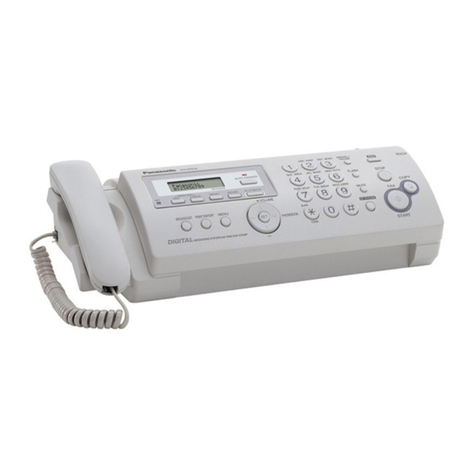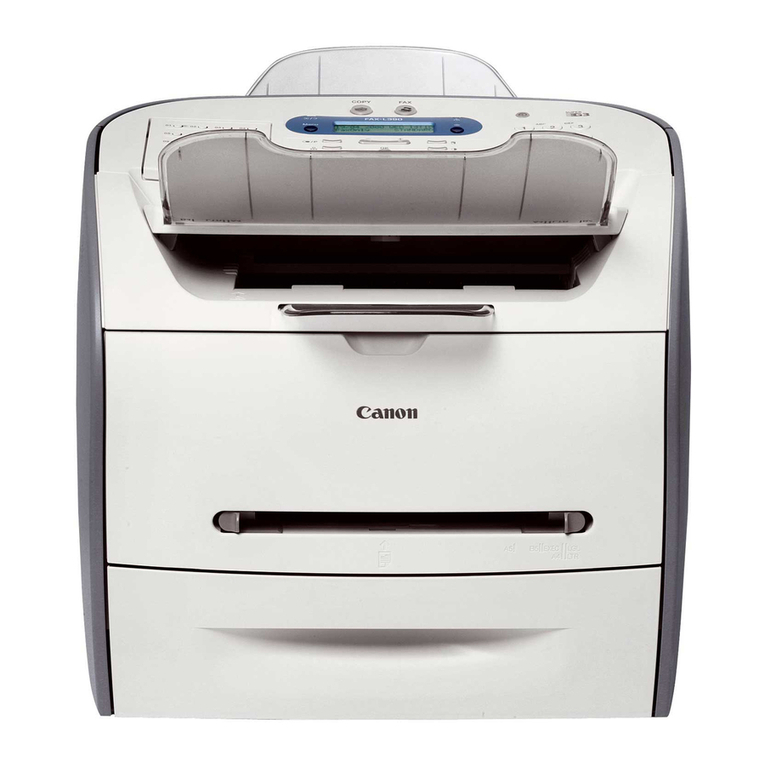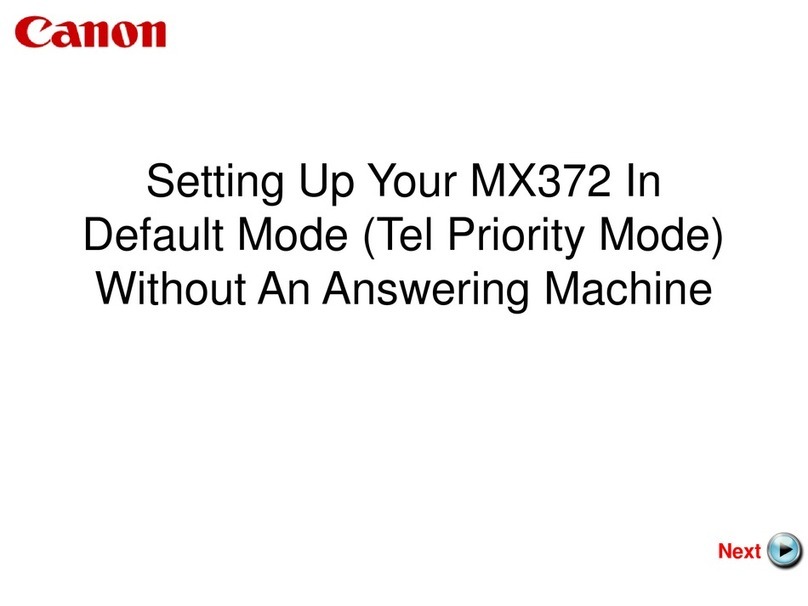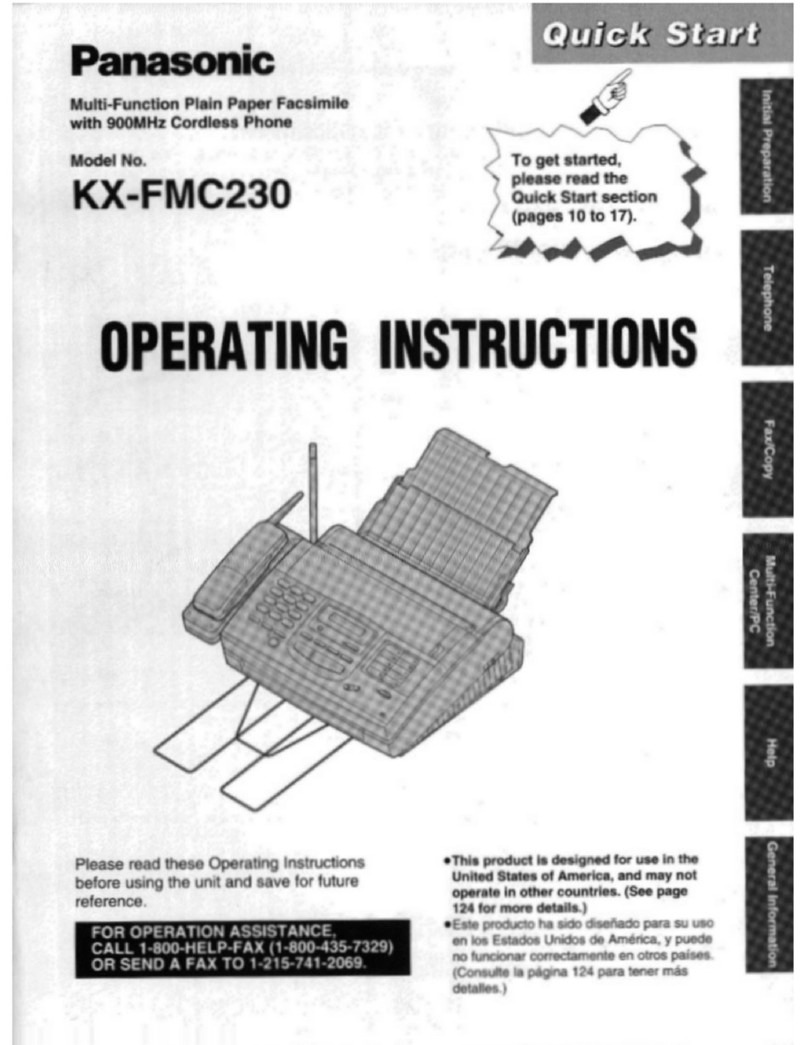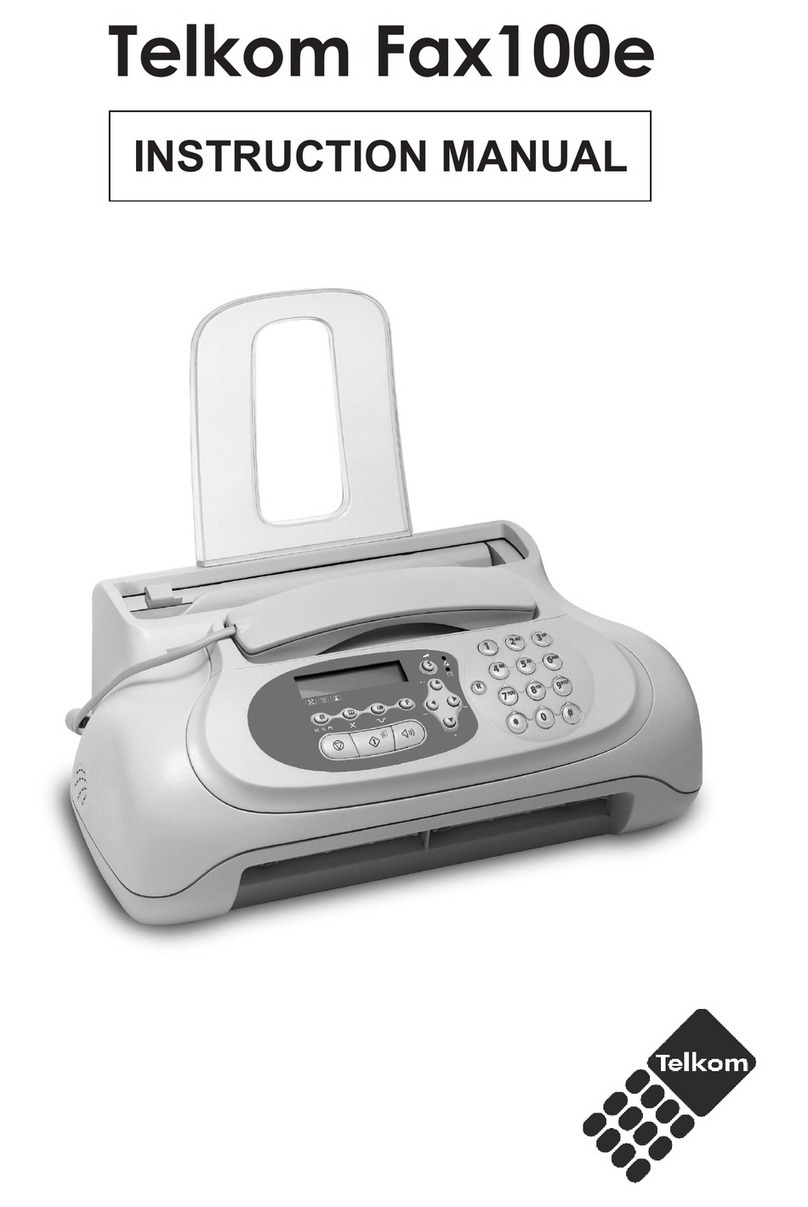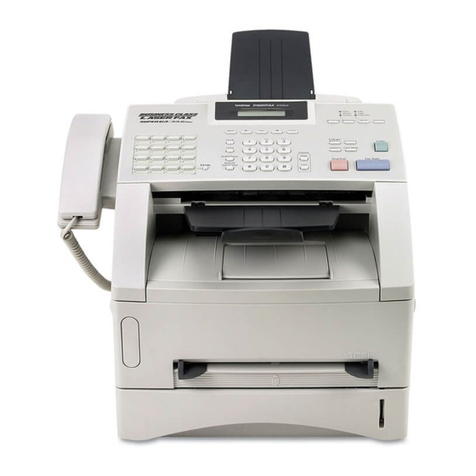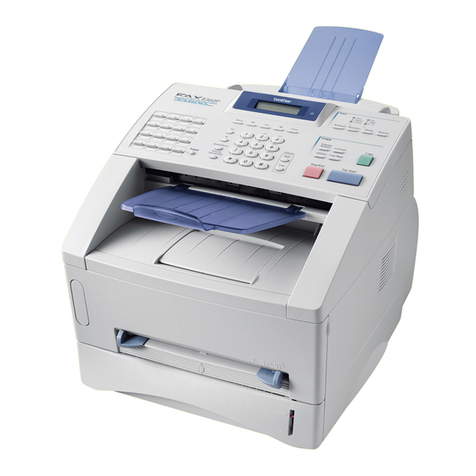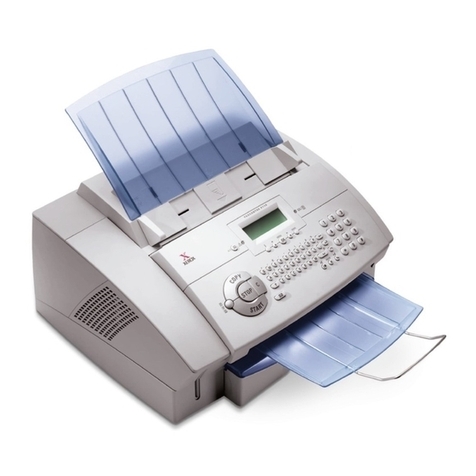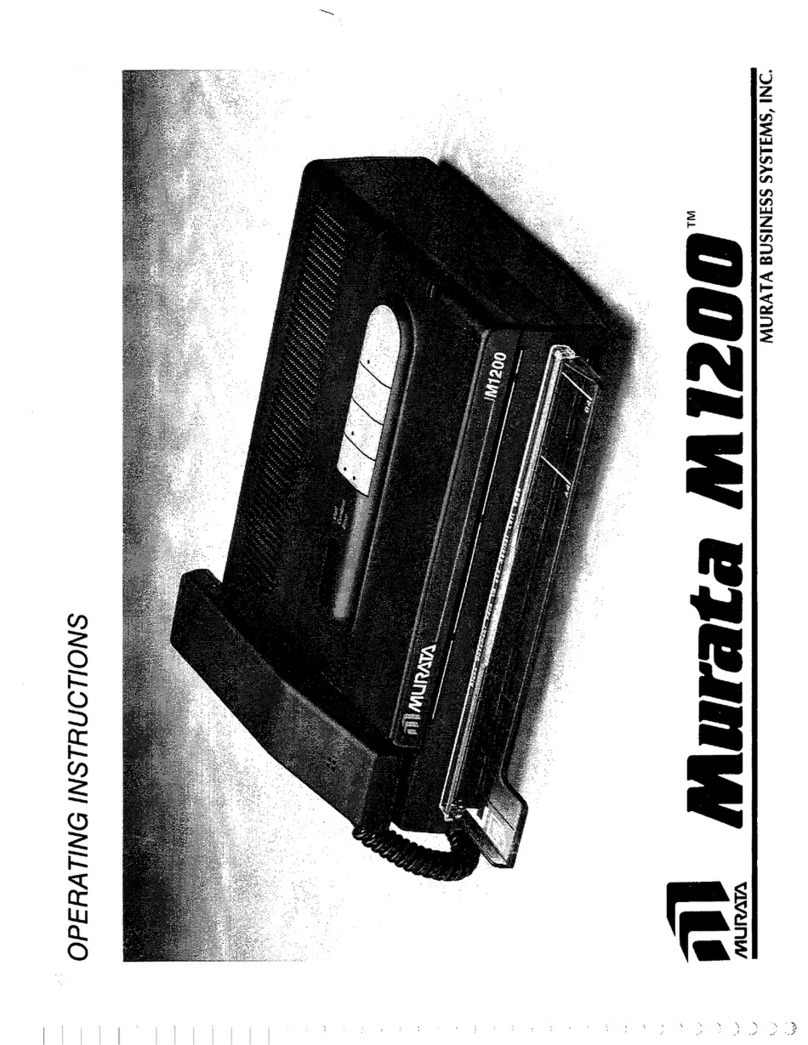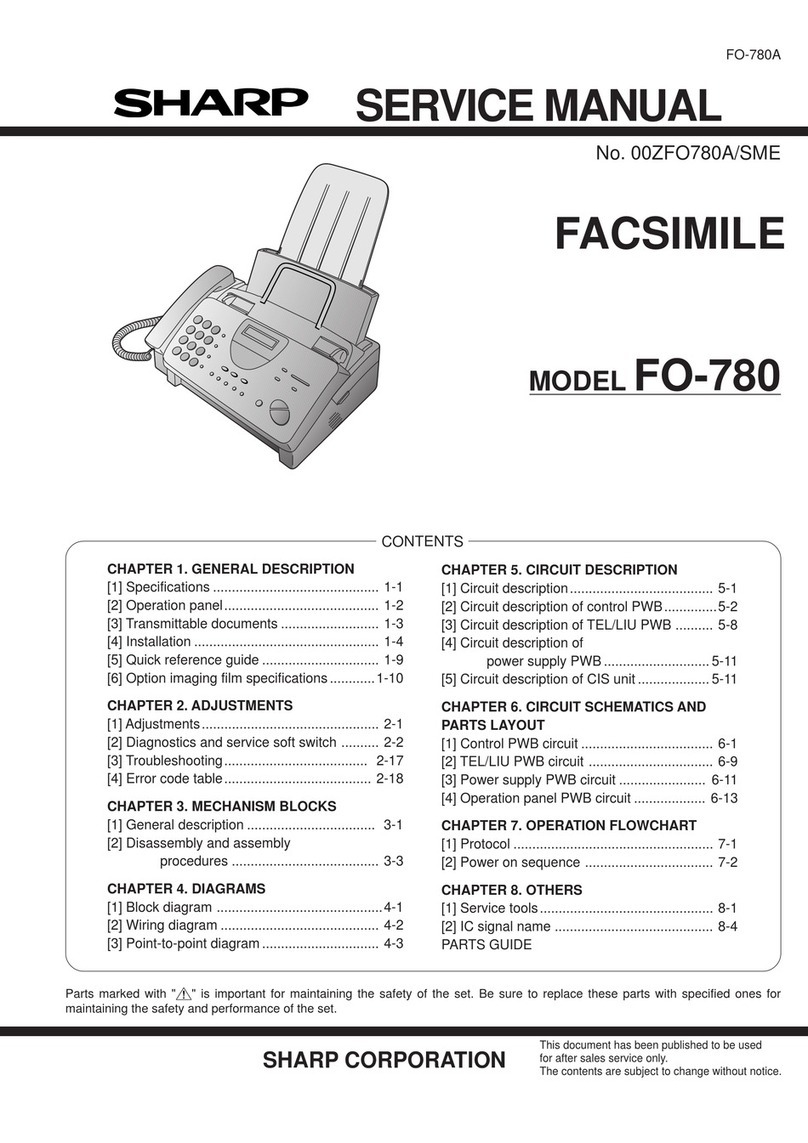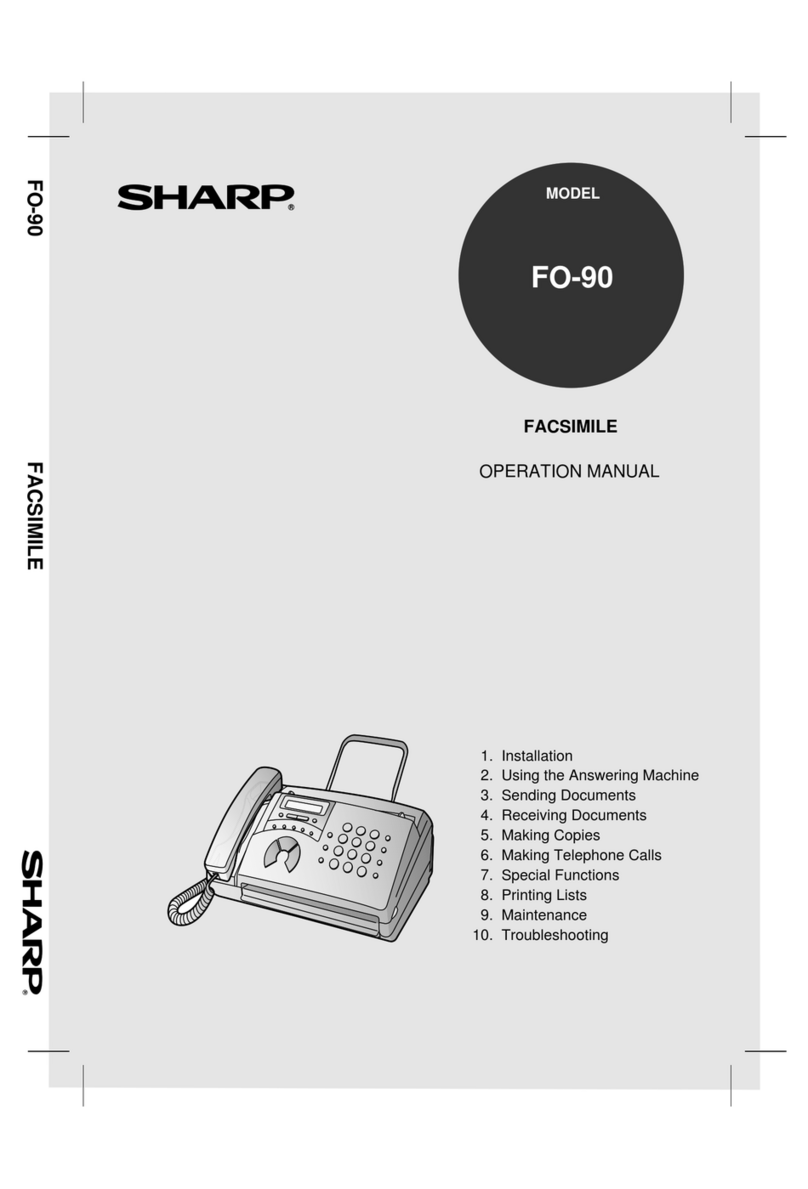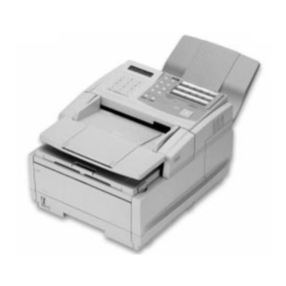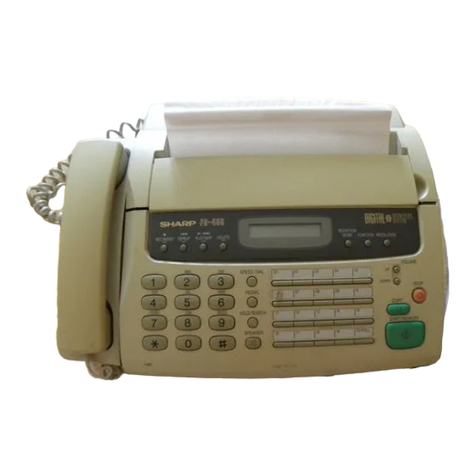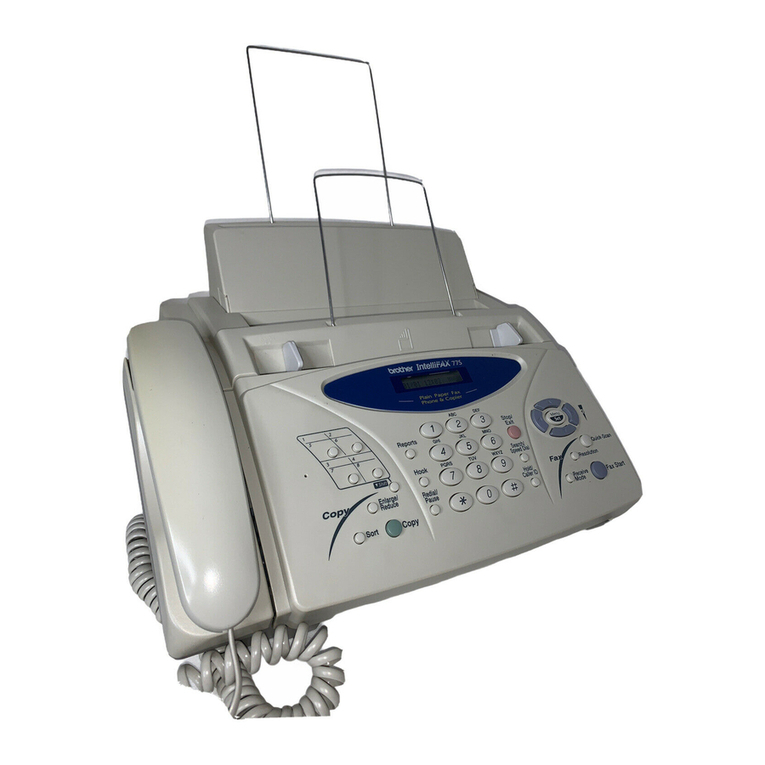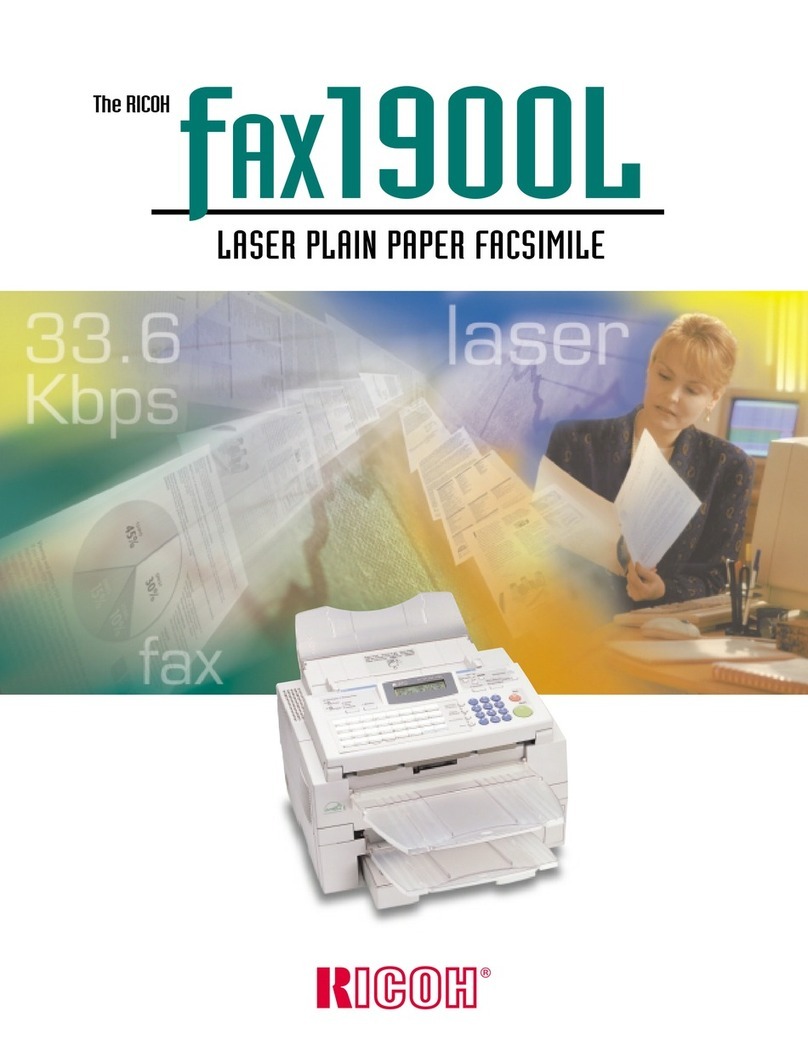Aficio 5000L User manual

KAISER 1
Aficio FAX 5000L
SERVICE MANUAL
29 November, 1999
Subject to change

Important Safety Notices
Laser Safety
øWARNING FOR LASER UNIT
This machine contains a laser beam generator. Laser beams can cause
permanent eye damage. Do not open the laser unit or look along the laser
beam path while the main power is on.
Lithium Batteries (Memory Back-up)
øCAUTION
The danger of explosion exists if a battery of this type is incorrectly
replaced.
Replace only with the same or an equivalent type recommended by the
manufacturer. Discard used batteries in accordance with the
manufacturer's instructions.
LASER_PS3.WMF

i
TABLE OF CONTENTS
1. OVERALL MACHINE INFORMATION........................................1-1
1.1 SPECIFICATIONS.................................................................................... 1-1
1.2 FEATURES............................................................................................... 1-3
1.2.1 FEATURES LIST............................................................................. 1-3
1.2.2 CAPABILITIES OF PROGRAMMABLE ITEMS............................... 1-7
1.3 COMPONENT LAYOUT........................................................................... 1-8
1.3.1 MECHANICAL COMPONENTS....................................................... 1-8
1.3.2 ELECTRICAL COMPONENTS...................................................... 1-10
1.3.3 DRIVE LAYOUT............................................................................. 1-14
1.4 POWER DISTRIBUTION........................................................................ 1-15
1.4.1 DISTRIBUTION DIAGRAM............................................................ 1-15
1.4.2 MEMORY BACK-UP CIRCUIT ...................................................... 1-17
2. DETAILED SECTION DESCRIPTIONS.......................................2-1
2.1 ADF/SCANNER........................................................................................ 2-1
2.1.1 OVERVIEW ..................................................................................... 2-1
2.1.2 DETAILED DESCRIPTIONS............................................................ 2-2
2.2 PRINTER.................................................................................................. 2-8
2.2.1 OVERVIEW ..................................................................................... 2-8
2.2.2 LASER EXPOSURE........................................................................ 2-9
2.2.3 AIO CARTRIDGE........................................................................... 2-13
2.2.4 TRANSFER AND PAPER SEPARATION...................................... 2-19
2.2.5 PAPER FEED................................................................................ 2-21
2.2.6 FUSING......................................................................................... 2-26
2.3 OPTIONAL PAPER FEED UNITS .......................................................... 2-33
2.3.1 OVERVIEW ................................................................................... 2-33
2.3.2 MECHANISMS............................................................................... 2-34
2.4 PCBS...................................................................................................... 2-38
2.4.1 FCU ............................................................................................... 2-38
2.4.2 OPIF (OPTION INTERFACE BOARD) .......................................... 2-41
2.4.3 NCU (US)....................................................................................... 2-42
2.4.4 NCU (EUROPE/ASIA) ................................................................... 2-43
2.4.5 PSU ............................................................................................... 2-44
2.5 SYSTEM FEATURES............................................................................. 2-45
2.5.1 PERSONAL/INFORMATION/TRANSFER BOXES........................ 2-45
2.5.2 BACKUP FILE TRANSMISSION ................................................... 2-48
2.5.3 STATUS INDICATOR.................................................................... 2-49
2.5.4 IMAGE ROTATION AND PAPER SELECTION............................. 2-49
3. INSTALLATION...........................................................................3-1
3.1 INSTALLING THE MACHINE................................................................... 3-1
3.2 INITIAL PROGRAMMING......................................................................... 3-1
3.3 FLOW CHART.......................................................................................... 3-2
3.4 INSTALLING OPTIONAL UNITS.............................................................. 3-3

ii
3.4.1 PAPER FEED UNIT TYPE 500........................................................ 3-3
3.4.2 JBIG UNIT TYPE 500...................................................................... 3-5
3.4.3 FEATURE EXPANDER TYPE 500 40M.......................................... 3-7
3.4.4 ISDN INTERFACE UNIT TYPE 500 (SIG4)..................................... 3-9
3.4.5 NIC FAX KIT TYPE 500................................................................. 3-13
3.4.6 G3 INTERFACE UNIT TYPE 500.................................................. 3-17
3.4.7 PC FAX EXPANDER TYPE 500.................................................... 3-22
3.4.8 FAX ON DEMAND TYPE 500........................................................ 3-25
3.4.9 COUNTER TYPE 100.................................................................... 3-27
3.4.10 PRINTER INTERFACE TYPE 500............................................... 3-28
3.4.11 NETWORK INTERFACE BOARD TYPE 2000 ............................ 3-32
4. SERVICE TABLES AND PROCEDURES ...................................4-1
4.1 SERVICE LEVEL FUNCTIONS................................................................ 4-1
4.1.1 BIT SWITCH PROGRAMMING (FUNCTION 01)............................. 4-1
4.1.2 SYSTEM PARAMETER LIST (FUNCTION 02)................................ 4-2
4.1.3 ERROR CODE DISPLAY (FUNCTION 03)...................................... 4-2
4.1.4 SERVICE MONITOR REPORT (FUNCTION 04)............................. 4-2
4.1.5 GROUP 3 PROTOCOL DUMP (FUNCTION 05) ............................. 4-3
4.1.6 RAM DISPLAY/REWRITE (FUNCTION 06)..................................... 4-3
4.1.7 RAM DUMP (FUNCTION 06)........................................................... 4-4
4.1.8 COUNTER DISPLAY/REWRITE (FUNCTION 07)........................... 4-4
4.1.9 NCU PARAMETERS (FUNCTION 08)............................................. 4-5
4.1.10 MODEM TEST (FUNCTION 08).................................................... 4-5
4.1.11 DTMF TONE TEST (FUNCTION 08)............................................. 4-6
4.1.12 V.8 MODEM TEST (FUNCTION 08).............................................. 4-6
4.1.13 V.34 MODEM TEST (FUNCTION 08)............................................ 4-7
4.1.14 OPERATION PANEL TEST (FUNCTION 09)................................ 4-7
4.1.15 XENON LAMP TEST (FUNCTION 10) .......................................... 4-8
4.1.16 ADF TEST (FUNCTION 10)........................................................... 4-8
4.1.17 PRINTER TEST PATTERNS (FUNCTION 11).............................. 4-9
4.1.18 SCANNER AND PRINTER MECHANISM TEST - FREE RUN
(FUNCTION 11).............................................................................. 4-9
4.1.19 RAM TESTS (FUNCTION 12)...................................................... 4-10
4.1.20 DATA COPY (FUNCTION 12) ..................................................... 4-10
4.1.21 SERVICE STATION FAX NUMBER (FUNCTION 13) ................. 4-11
4.1.22 SERIAL NUMBER (FUNCTION 14)............................................. 4-11
4.1.23 40 MB FLASH MEMORY INITIALIZATION (FUNCTION 16)....... 4-12
4.1.24 40 MB FLASH MEMORY FORMATTING (FUNCTION 16).......... 4-12
4.1.25 40 MB FLASH MEMORY TEST (FUNCTION 16)........................ 4-13
4.1.26 G4 PARAMETER PROGRAMMING (FUNCTION 17) ................. 4-13
4.1.27 OPTIONAL G3 BIT SWITCHES (FUNCTION 18)........................ 4-14
4.1.28 OPTIONAL SG3 BOARD RAM DUMP (FUNCTION 18).............. 4-14
4.1.29 OPTIONAL SG3 BOARD NCU PARAMETERS (FUNCTION 18) 4-15
4.1.30 OPTIONAL SG3 BOARD MODEM TEST (FUNCTION 18)......... 4-16
4.1.31 OPTIONAL SG3 BOARD DTMF TONE TEST (FUNCTION 18).. 4-17
4.1.32 OPTIONAL SG3 BOARD V.8 MODEM TEST (FUNCTION 18)... 4-18
4.1.33 OPTIONAL SG3 BOARD V.34 MODEM TEST (FUNCTION 18). 4-19
4.1.34 JBIG TEST (FUNCTION 21)........................................................ 4-19

iii
4.2 BIT SWITCHES...................................................................................... 4-20
4.2.1 SYSTEM SWITCHES.................................................................... 4-20
4.2.2 SCANNER SWITCHES ................................................................. 4-35
4.2.3 PRINTER SWITCHES................................................................... 4-38
4.2.4 COMMUNICATION SWITCHES.................................................... 4-41
4.2.5 G3 SWITCHES.............................................................................. 4-51
4.2.6 G3-2 SWITCHES........................................................................... 4-58
4.3 NCU PARAMETERS .............................................................................. 4-64
4.4 DEDICATED TRANSMISSION PARAMETERS..................................... 4-74
4.4.1 PROGRAMMING PROCEDURE................................................... 4-74
4.4.2 PARAMETERS.............................................................................. 4-75
4.5 SERVICE RAM ADDRESSES................................................................ 4-78
5. PREVENTIVE MAINTENANCE...................................................5-1
5.1 SPECIAL TOOLS AND LUBRICANTS ..................................................... 5-1
5.2 PM TABLE................................................................................................ 5-1
6. REPLACEMENT AND ADJUSTMENT........................................6-1
6.1 EXTERNAL COVERS............................................................................... 6-1
6.1.1 REMOVING THE ADF FRONT AND REAR COVERS.................... 6-1
6.1.2 REMOVING THE UPPER GUIDE PLATE....................................... 6-1
6.1.3 REMOVING THE REAR COVER..................................................... 6-2
6.1.4 REMOVING THE OPERATION PANEL AND FRONT COVER....... 6-3
6.2 ADF/SCANNER SECTIONS..................................................................... 6-4
6.2.1 REPLACING THE PICK-UP ROLLER
(PART OF THE ADF MAINTENANCE KIT)...................................... 6-4
6.2.2 REPLACING THE FEED ROLLER
(PART OF THE ADF MAINTENANCE KIT)...................................... 6-4
6.2.3 REPLACING THE REVERSE ROLLER AND TORQUE
LIMITER (PART OF THE ADF MAINTENANCE KIT)....................... 6-5
6.2.4 REPLACING THE R0 ROLLER....................................................... 6-6
6.2.5 REPLACING THE R1, R2 AND DOCUMENT EXIT ROLLERS....... 6-7
6.2.6 REPLACING THE OPTICAL UNIT (SCANNER).............................. 6-9
6.2.7 REMOVING THE STAMP UNIT..................................................... 6-11
6.2.8 ADJUSTING THE SCANNING TOP MARGIN............................... 6-11
6.3 LASER UNIT........................................................................................... 6-12
6.3.1 REPLACING THE LASER SYNCHRONIZATION DETECTOR
AND LD UNITS............................................................................... 6-12
6.3.2 REPLACING THE POLYGON MOTOR......................................... 6-13
6.3.3 ADJUSTING THE PRINTING SIDE-TO-SIDE REGISTRATION.... 6-14
6.4 AIO CARTRIDGE ................................................................................... 6-15
6.4.1 REPLACING THE AIO CARTRIDGE............................................. 6-15
6.4.2 REPLACING THE TRANSFER ROLLER (PART OF
THE FUSING MAINTENANCE KIT)............................................... 6-16
6.4.3 REPLACING THE POWER PACK................................................. 6-17
6.5 PAPER FEED AND REGISTRATION..................................................... 6-18
6.5.1 REPLACING THE PAPER FEED ROLLER................................... 6-18
6.5.2 REPLACING THE REGISTRATION ROLLER............................... 6-19
6.5.3 ADJUSTING THE PRINTING TOP MARGIN................................. 6-20

iv
6.6 SENSORS.............................................................................................. 6-21
6.6.1 REPLACING THE ADF/MDF SENSORS AND SWITCHES .......... 6-21
6.6.2 REPLACING THE PAPER-END LED BOARD
AND PAPER SIZE SENSOR SWITCH........................................... 6-23
6.6.3 REPLACING THE AIO CARTRIDGE SENSOR............................. 6-24
6.6.4 REPLACING THE PAPER EXIT SENSOR.................................... 6-25
6.6.5 REPLACING THE PAPER NEAR-END SENSOR......................... 6-26
6.6.6 REPLACING THE PAPER END SENSOR .................................... 6-27
6.6.7 REPLACING THE TONER END SENSOR.................................... 6-28
6.6.8 REPLACING THE REGISTRATION SENSOR.............................. 6-29
6.7 FUSING UNIT......................................................................................... 6-30
6.7.1 REPLACING THE FUSING UNIT (PART OF THE FUSING
MAINTENANCE KIT)..................................................................... 6-30
6.7.2 DISASSEMBLING THE FUSING UNIT.......................................... 6-31
6.7.3 REPLACING THE PRESSURE ROLLER...................................... 6-32
6.7.4 REPLACING THE HOT ROLLER, FUSING LAMP, AND
THERMOFUSE............................................................................... 6-33
6.7.5 REPLACING THE THERMISTOR ................................................. 6-34
6.7.6 REPLACING THE HOT ROLLER STRIPPERS............................. 6-35
6.8 PCBS...................................................................................................... 6-36
6.8.1 REPLACING THE PSU.................................................................. 6-36
6.8.2 REPLACING THE NCU/FCU......................................................... 6-37
6.8.3 REPLACING THE OPERATION PANEL, LCD CONTROLLER,
AND INVERTER BOARD ............................................................... 6-38
6.9 DATA AND FIRMWARE DOWNLOAD/UPLOAD ................................... 6-39
6.9.1 FCU PROGRAM DOWNLOAD (IC CARD TO MACHINE) ............ 6-39
6.9.2 FCU PROGRAM UPLOAD (MACHINE TO IC CARD)................... 6-40
6.9.3 FCU SRAM RESTORE (IC CARD OR PREVIOUS FCU TO
MACHINE)...................................................................................... 6-41
6.9.4 FCU SRAM BACKUP (MACHINE TO IC CARD)........................... 6-42
6.9.5 OPTIONAL G3 UNIT CONTROL PROGRAM DOWNLOAD
(IC CARD TO MACHINE)............................................................... 6-42
6.9.6 OPTIONAL G3 UNIT MODEM PROGRAM DOWMLOAD
(IC CARD TO MACHINE)............................................................... 6-43
6.9.7 G4 UNIT PROGRAM DOWNLOAD (IC CARD TO MACHINE)...... 6-43
6.9.8 NICF PROGRAM DOWNLOAD (IC CARD TO MACHINE)............ 6-44
6.10 OPTIONAL PAPER FEED UNIT........................................................... 6-45
6.10.1 REMOVING THE PAPER FEED TRAY....................................... 6-45
6.10.2 REMOVING THE VERTICAL FEED UNIT................................... 6-45
6.10.3 REMOVING THE REAR COVER................................................. 6-46
6.10.4 REPLACING THE PAPER-END LED BOARD AND PAPER
SIZE SENSOR SWITCH............................................................... 6-46
6.10.5 REPLACING THE PAPER FEED ROLLERS............................... 6-47
6.10.6 REPLACING THE PAPER FEED SENSOR................................ 6-48
6.10.7 REPLACING THE UPPER LIMIT AND PAPER END
SENSORS................................................................................... 6-49
6.10.8 REPLACING THE PAPER NEAR-END SENSOR....................... 6-50
6.10.9 REPLACING THE LEFT SIDE COVER SWITCH AND PAPER
FEED CLUTCH............................................................................ 6-51

v
6.10.10 REPLACING THE PAPER FEED AND LIFT MOTORS............. 6-52
6.10.11 REPLACING THE PFU BOARD................................................ 6-53
7. TROUBLESHOOTING.................................................................7-1
7.1 COPY QUALITY TROUBLESHOOTING .................................................. 7-1
7.1.1 BLANK COPIES............................................................................... 7-2
7.1.2 BLACK COPIES............................................................................... 7-2
7.1.3 DIRTY BACKGROUND ................................................................... 7-3
7.1.4 UNEVEN IMAGE DENSITY............................................................. 7-4
7.1.5 VERTICAL BLACK LINES ............................................................... 7-5
7.1.6 HORIZONTAL BLACK LINES.......................................................... 7-6
7.1.7 VERTICAL WHITE LINES ............................................................... 7-7
7.1.8 HORIZONTAL WHITE LINES.......................................................... 7-8
7.1.9. BLACK DOTS/SPOTS.................................................................... 7-9
7.1.10 WHITE SPOTS IN BLACK IMAGE AREAS ................................. 7-10
7.1.11 FAINT COPIES............................................................................ 7-11
7.1.12 VERTICAL BLACK BAND............................................................ 7-13
7.1.13 UNFUSED COPIES..................................................................... 7-14
7.1.14 GHOST IMAGE............................................................................ 7-14
7.1.15 TONER ON THE BACK OF THE PRINTER PAPER................... 7-15
7.1.16 INCORRECTLY ALIGNED OUTPUT (DATA SHIFTED TO
THE RIGHT OR LEFT)................................................................ 7-15
7.1.17 INCORRECTLY ALIGNED OUTPUT (IMAGE SHIFTED
VERTICALLY)/REDUCED IMAGE .............................................. 7-16
7.2 MECHANICAL PROBLEMS ................................................................... 7-17
7.2.1 ADF/SCANNER............................................................................. 7-17
7.2.2 PRINTER....................................................................................... 7-20
7.3 SERVICE CALL CONDITIONS............................................................... 7-23
7.4 ERROR CODES..................................................................................... 7-25
7.5 MODEM STATUS CODES IN V.34 PROTOCOL DUMP........................ 7-35
7.5.1 CALLING SIDE.............................................................................. 7-35
7.5.2 CALLED SIDE................................................................................ 7-39

November 29, 1999 SPECIFICATIONS
1-1
Overall
Information
1. OVERALL MACHINE INFORMATION
1.1 SPECIFICATIONS
Type
Desktop type transceiver
Circuit
PSTN, PABX, ISDN (optional)
Connection
Direct couple
Document Size
Length:
105 - 420 mm [4.1 - 16.5 ins]
Up to 1.2 m [47.2 ins], manually assisted
Width:
148 - 304 mm [5.8 - 12.0 ins]
Thickness:
0.05 to 0.2 mm [2 to 8 mils]
(equivalent to 50 - 80 g/m2)
Document Feed
Automatic feed, face up
ADF Capacity
75 sheets (using A4 size 75g/m2paper)
40 sheets (using B4 size 75g/m2paper)
30 sheets (using A3 size 75g/m2paper)
Scanning Method
Flat bed, with CCD
Scan Width
219.5 mm [8.64 ins] ±1% (A4/Letter)
260.1 mm [10.2 ins] ±1% (B4)
308.9 mm [12.2 ins] ±1% (A3/Double
Letter)
Scan Resolutions
Main scan: 200 dpi
Sub scan:
Standard - 100 lpi
Detail - 200 lpi
Fine - 400 lpi
Memory Capacity
ECM: 128 kbytes
SAF:
Standard: 2.0 Mbytes: 160 pages
With 2 Mbyte option: 320 pages
With 4 Mbyte option: 480 pages
With 40 Mbyte option: 1200 pages
With 40 Mbyte option plus Function
Upgrade Card: 3000 pages
Measured using ITU-T #1 test document
(Slerexe letter)
Compression
MH, MR, MMR, SSC
JBIG (JBIG option is required)
SAF storage for memory tx: MMR and raw
data
Protocol
Group 3 with ECM
Group 4 (ISDN G4 option required)
Modulation
V.34 (TCM), V.33/V.17(TCM), V.29 (QAM),
V.27ter (PHM), V.21 (FM), V.8 (FM)
Data Rate (bps)
G3:
33600/31200/28800/26400/24000/21600/
19200/16800/14400/12000/9600/7200/
4800/2400
G4 (option): 64 kbps/56 kbps
I/O Rate
With ECM: 0 ms/line
Without ECM: 2.5, 5, 10, 20, or 40 ms/line
Transmission Time
G3: 3 s at 28800 bps;
Measured with G3 ECM using memory for
an ITU-T #1 test document (Slerexe letter)
at standard resolution
G4 (option): 3 s at 64 kbps;
Measured with an ITU-T #1 test document
(Slerexe letter) at standard resolution
Printing System
Laser printing, plain paper, dry toner

SPECIFICATIONS November 29, 1999
1-2
Paper Size and Capacity
Standard Cassette: 250 sheets
USA: Letter, Legal, DLT
Europe: A4, A5 sideways, B4, A3
Asia: A4, A5 sideways, F/F4, B4, A3
Paper Feed Unit (Optional): 500 sheets
USA: Letter, Legal, DLT
Europe: A4, A5 sideways, B4, A3
Asia: A4, A5 sideways, F/F4, B4, A3
Note: Up to two PFUs can be installed.
Maximum Printing Width
208 mm [8.2 ins] (Letter)
202 mm [8.0 ins] (A4)
248 mm [9.8] (B4)
288 mm [11.3] (A3, DLT)
Print Resolutions
Fax and Copy Mode:
Main scan: 400 dpi
Sub scan: 400 dpi
Printer Mode: 600 dpi
Power Supply
USA: 115 ±20 Vac, 50 ±1 Hz
Europe/Asia: 187 - 276 Vac, 60 ±1 Hz
Power Consumption (Base Machine
Only)
Standby:
Minimum 2 W (see Note)
Normal 45 W
Transmitting: 70 W
Receiving: 400 W (Maximum: 850 W)
Copying: 400 W (Maximum: 850 W)
Note: 2W mode is not available if one of the
following options is installed.
- Printer interface unit
- G4
- RS232C interface
- G3 interface
- NIC (Internet Fax option)
Operating Environment
Temperature: 10°C - 32°C [50 - 90°F]
Humidity: 10 - 80 %Rh
Dimensions (W x D x H)
505 x 609 x 450 mm [19.9 x 24.0 x 17.7 ins]
Excluding handset, trays, and optional units
Weight
Approx. 26.5 kg [58.6 lbs]
Excluding AIO, maintenance kit, handset,
trays, and optional units

November 29, 1999 FEATURES
1-3
Overall
Information
1.2 FEATURES
1.2.1 FEATURES LIST
KEY:
O = Used, X = Not Used,
A = With optional memory 2M/4M/40M
only
B = With optional function upgrade
card only
C = With optional Fax On Demand kit
only
D = With optional paper feed unit only
E = With optional counter only
F = With optional handset only (US
only)
G= With optional printer interface unit
only
H = With optional G4 kit only
Equipment
ADF O
Book scan X
Built-in handset X
Bypass feed: 1 sheet O
Cabinet X
Counter E
Cutter X
Handset F
Hard disk X
Manual feed mechanism
(ADF) O
Marker (Stamp) O
Monitor speaker O
Optional cassette: 100 sheets X
Optional Fax On Demand kit C
Optional paper feed unit
(up to 2 units) D
Optional printer interface G
Video Processing Features
Contrast O
Halftone
(Basic & Error Diffusion) O
MTF O
Reduction before tx (B4 -> A4) O
Reduction before tx (A3 -> B4) O
Video Processing Features
Reduction before tx (A3 -> A4) O
Scanning Resolution -
Standard O
Scanning Resolution - Detail O
Scanning Resolution - Fine O
Scanning Resolution -
Superfine X
Smoothing to 400 x 400 dpi
when printing O
Communication Features - Auto
Automatic fallback O
Automatic redialing O
Confidential reception O
Dual Access O
Substitute reception O
Communication Features -
User Selectable
Action as a transfer
broadcaster O
AI Redial (last ten numbers) O
Answering machine interface X
Authorized Reception O
Auto-answer delay time X
Auto dialing (pulse or DTMF) O
Auto Document O
Auto image density selection X
Auto paper size selection X
Automatic Voice Message X
Batch Transmission O
Broadcasting O
Chain Dialing O
Communication Result Display O
Confidential ID Override O
Confidential Reception O
Confidential Transmission O
Direct Fax Number Entry O
Economy Transmission O
Fax on demand C
F code Box O
Forwarding O
Free Polling O
Groups (9 groups) O
Group Transfer Station O

FEATURES November 29, 1999
1-4
Communication Features -
User Selectable
Hold X
ID Transmission O
Immediate Redialing O
Immediate transmission O
Keystroke Programs O
Length Reduction X
Memory transmission O
Multi-step Transfer O
OMR X
On Hook Dial O
Ordering Toner X
Page Count O
Page separation mark O
Parallel memory transmission O
Personal Codes X
Personal Codes with Conf. ID X
Partial Image Area Scanning B
Polling Reception O
Polling Transmission O
Polling tx file lifetime in the
SAF O
Quick Dial
(Standard: 64 stations) O
Reception modes (Fax, Tel) O
Remote control features X
Remote Transfer O
Restricted Access O
Secured Polling O
Secured Polling with Stored ID
Override O
Secure Transmission X
Send Later O
Silent ringing detection X
Speed Dial
(Standard: 100 stations) O
Telephone Directory O
Tonal Signal Transmission O
Transfer Request O
Transmission Deadline (TRD) X
Turnaround Polling X
Two-step Transfer X
Two in one O
Voice Request (immed. tx
only) X
Communication Features -
Service Selectable
AI Short Protocol O
Auto-reduction override option O
Busy tone detection O
Cable Equalizer
PSTN
ISDN O
H
Closed Network (tx and rx) O
Continuous Polling Reception O
Dedicated tx parameters O
ECM O
EFC X
Inch-mm conversion before
transmission O
mm-inch conversion when
printing O
Page retransmission times O
Protection against wrong
conn. O
Resolutions available for
reception
200 x 100 dpi
200 x 200 dpi
200 x 400 dpi
400 x 400 dpi
O
O
O
X
Resolution stepdown override
option X
Short Preamble X
Other User Features
Area code prefix X
Automatic service call Service
Center mark O
Checkered mark O
Clearing a memory file O
Clearing a polling file O
Clock O
Confidential ID O
Copy editing
(Erase Center/Margin) X
Copy mode O
Copy Mode Restriction O
Counters O
Daylight Saving Time O
Destination Check O
Direct entry of names O

November 29, 1999 FEATURES
1-5
Overall
Information
Other User Features
File Retention Time O
File Retransmission O
Function Programs O
ID Code O
Label Insertion (“From xxx”)O
Language Selection O
LCD contrast control O
Memory Lock O
Memory Lock ID O
Multi Sort Document
Reception O
Multicopy mode O
Own telephone number O
Energy Saver (Night Timer
and standby mode) O
Print density control O
Printing a memory file O
RDS on/off O
Reception Mode Switching
Timer X
Reception time printing O
Reduction/Enlargement X
Remaining memory indicator O
Remote ID O
Reverse Order Printing X
RTI, TTI, CSI O
Service Report Transmission O
Speaker volume control O
Specified Tray Selection D
Substitute reception on/off O
Telephone line type O
Toner Saving Mode O
TTI/CIL on/off O
User Function Keys (5 keys) O
User Parameters O
Wild Cards O
Reports - Automatic
Communication Failure Report O
Confidential File Report O
Fax On Demand Report C
Memory Storage Report O
Polling Clear Report O
Polling Reserve Report O
Polling Result Report X
Reports - Automatic
Power Failure Report O
TCR (Journal) O
Toner Cassette Order Form X
Transfer Result Report O
Transmission Result Report O
Reports - User-initiated
Authorized Destination List O
Box List O
Charge Control Report X
File List O
Forwarding List O
Group List O
Personal Code List O
Program List O
Quick Dial List O
Specified Tray Selection List O
Speed Dial List O
Journal O
Transmission Status Report X
User Function List X
User Parameter List O
Service Mode Features
Auto Paper Select test X
Back-to-back test X
Bit switch programming O
Book mode test X
Buzzer test O
Cable equalizer O
Comm. parameter display O
Counter check O
Country code O
DTMF tone test O
Echo countermeasure O
Effective term of service calls O
Error code display O
Excessive jam alarm O
File Transfer O
Line error mark O
Memory file printout (all files) O
Modem test O
NCU parameters O
Operation panel test O

FEATURES November 29, 1999
1-6
Service Mode Features
Periodic service call O
PM Call O
Printer mechanism test O
Printer test patterns O
Programmable attenuation X
Protocol dump list O
RAM display/rewrite O
RAM dump O
RAM test O
Ringer test X
Scanner lamp test O
Scanner mechanism test O
Sensor initialization X
Serial number O
Service monitor report O
Service station number O
Software upload/download O
SRAM data download O
System parameter list O
Technical data on the Journal O
Thermal head parameters X
Transmission Status Report X
User data transfer O

November 29, 1999 FEATURES
1-7
Overall
Information
1.2.2 CAPABILITIES OF PROGRAMMABLE ITEMS
The following table shows how the capability of each programmable item changes
after the optional function upgrade card is installed.
Maximum number of Standard With function
upgrade card
Memory files plus polling rx files 250 1000
Memory files 250 1000
Destinations per file 250 1000
Destinations overall 500 2000
Pages overall 1200 3000
Quick Dials 64 64
Speed Dials 100 1000
Groups 9 30
Destinations per Group 250 250
Boxes (Information/Personal/Transfer) 150 400
Destinations dialed from the ten-key pad
overall 100 1000
Programs 64
(programmed in 64
Quick Dial keys)
164
(programmed in 64
Quick Dial keys plus
100 Speed Dial
codes)
Destinations per program 250 250
Auto Documents 64
(programmed in 64
Quick Dial keys)
164
(programmed in 64
Quick Dial keys plus
100 Speed Dial
codes)
Communication records for the Journal
stored in the memory 256 1000
Addresses specified for features such as
Authorized Reception and Specified
Cassette Selection
30 50

COMPONENT LAYOUT November 29, 1999
1-8
1.3 COMPONENT LAYOUT
1.3.1 MECHANICAL COMPONENTS
No Name Description
1MDF (Manual Document
Feeder) Feeds non-standard size documents.
2 R0 Roller Feeds the document through the scanner.
3 R1 Roller Feeds the document through the scanner.
4 Document Feed Roller Feeds the document into the scanner.
5 Reverse Roller Allows one page into the scanner.
6 Pick-up Roller Picks up pages of the document from the document
table one at a time.
7 R2 Roller Feeds the document through the stamp to the exit
8 Exit Roller Feeds the document out to the document tray.
9 Laser Unit Consists of the LDDR (Laser Diode Driver), focusing
lens, hexagonal mirror motor, and other laser optic
components.
10 Paper Pick-up Roller Picks up the top sheet of paper from the stack in the
tray, and feeds it into the printer.
11 Paper Feed Roller Feeds the paper towards the registration roller.
12 Registration Roller Carries out the registration process.
13 Transfer Roller Transfers toner from the drum to the paper.
H306V501.WMF
1 2 3 4 5 6 7 8
9
10
11
12
14
15
16
17
13

November 29, 1999 COMPONENT LAYOUT
1-9
Overall
Information
No Name Description
14 OPC Drum The latent image is written to this organic
photoconductor drum.
15 All-in-One Cartridge Consists of the toner cartridge, cleaning unit, used
toner tank, charge brush roller, development roller and
OPC drum.
16 Fusing Pressure Roller Applies pressure to the paper during the fusing
process.
17 Hot Roller Heat from this roller fuses the toner to the copy paper.

COMPONENT LAYOUT November 29, 1999
1-10
1.3.2 ELECTRICAL COMPONENTS
H306V502.WMF
H306V503.WMF
1 2 3
4
5
6
7
8
9
10
11
12
13 14
16 17 18
19
20
21
22
23
24
25
26
27
28
29
30
31
32
33
34
35
36
15

November 29, 1999 COMPONENT LAYOUT
1-11
Overall
Information
1. PCBs
No Name Description
4 Lamp Stabilizer Stabilizes the power to the exposure lamp
6 SBU The sensor on this board (a CCD) reads and converts
the light reflected from the document into an analog
video signal.
27 Paper End/Near-end
Indicator Board Lights an LED when the paper in the tray has run out.
32 LDDR (Laser Diode
Driver) This board drives the laser diode.
36 FCU (Facsimile Control
Unit) This board controls the machine. It contains the main
CPU, flash ROM, system RAM and so on.
37 NCU (Network Control
Unit) for optional G3 unit. This board contains relays and switches for interfacing
the machine with the network and the handset.
38 Power Pack Supplies high voltage to the charge brush roller,
transfer roller, and development rollers.
39 NCU (Network Control
Unit) This board contains relays and switches for interfacing
the machine with the network.
40 PSU (Power Supply
Unit) This board supplies power to the machine, and
switches the fusing lamp on/off.
41
42 Printer Interface Unit
(Optional) This allows the machine to be connected to a
computer as a laser printer.
43 NIB (Network Interface
Board)
(Optional)
This allows the machine with printer unit to be
connected to a LAN as a network printer.
H306V003.WMF
37 38 39
40
41
42
43
44
45
46
47
48
49
50

COMPONENT LAYOUT November 29, 1999
1-12
No Name Description
45 JBIG
(Optional) This allows the machine to communicate using JBIG
compression.
46 Internet Fax Board
(Optional) This allows the machine to be connected to a LAN as
an internet fax machine.
47 LCD This displays messages and the status of the
machine.
48 OPU (Operation Panel
Unit) This board controls the operation panel.
49 OPIF (Optional
Interface) This allows the machine to be connected to a G4 unit,
internet fax unit, and some other options.
50 G4 Interface (SiG4
option) or Optional G3
unit
This is an interface for the machine to connect to an
ISDN network or an extra PSTN line. Only one of
these two boards can be installed in the machine.
The standard G3 line is sometimes called PSTN-1,
and the optional G3 line is sometimes called PSTN-2.
2. Motors
No Name Description
3 Scanner Motor This stepper motor drives the scanner.
20 Cooling Fan Motor Cools the interior of the machine.
24 Polygon Mirror Motor This high-speed DC motor drives the hexagonal mirror
in the laser printer optics.
27 Main Motor This stepper motor drives the AIO cartridge and the
fusing unit.
35 Paper Feed Motor This stepper motor drives the registration roller and
the paper feed mechanisms in the main body.
3. Sensors
No Name Description
1 B4-width Sensor This detects the presence of a B4-width (256 mm,
10.1") document in the feeder.
2 ADF Upper Cover Switch This detects whether the ADF upper cover is opened
or closed.
7 ADF Unit Switch This detects whether the ADF unit is opened or
closed.
8 Paper Exit Sensor Detects when the paper feeds out of the printer.
9 A3-width Sensor This detects the presence of an A3-width (297 mm,
11.7")document in the feeder.
10 MDF A3-width Sensor This detects the presence of an A3-width (297 mm,
11.7")document in the MDF.
11 MDF B4-width Sensor This detects the presence of a B4-width (256 mm,
10.1")document in the MDF.
12 Scan Line Sensor This detects when a page is approaching the auto
shading position.
13 Document Sensor This detects the presence of a document in the
feeder.

November 29, 1999 COMPONENT LAYOUT
1-13
Overall
Information
No Name Description
14 MDF Sensor This detects the presence of a document in the MDF.
16 Thermistor This monitors the temperature at the hot roller
surface.
17 Thermofuse This interrupts the AC power to the fusing lamp if the
temperature of the thermistor exceeds 470°C.
22 Paper End Sensor Detects when the paper in the tray has run out.
23 AIO Cartridge Sensor This detects whether the AIO cartridge is installed or
not.
25 Laser Synchronization
Detector Detects the laser beam at the start of the main scan.
28 Paper Tray Side Cover
Switch Detects whether the paper tray side cover is opened
or closed.
30 Paper Size Detector This detects the paper size installed in the tray. The
user must set the dial to the correct size.
32 Toner End Sensor Detects when the toner has run out.
34 Registration Sensor Detects when paper reaches the registration roller.
36 Paper Near End Sensor Detects when the paper has almost run out.
4. Interlock Switch
No Name Description
31 Interlock Switch If the left cover is opened, this switch interrupts the
+5VLDL power supply for the laser diode and the
+24VM power supply for the fusing lamp.
5. Others
No Name Description
5 Stamper Ass’y This stamps a red circle on each page that is
successfully fed through the scanner (for memory
transmission) or transmitted (for immediate
transmission).
15 Xenon Lamp Applies high intensity light to the original for exposure.
18 Fusing Lamp The heat from this lamp fuses the toner to the paper.
19 Registration Clutch Transfers drive from the paper feed motor to the
registration roller.
21 Paper Feed Clutch Transfers drive from the paper feed motor to the
paper feed roller.
26 Monitor Speaker Allows the user to hear the telephone line condition.
Table of contents
